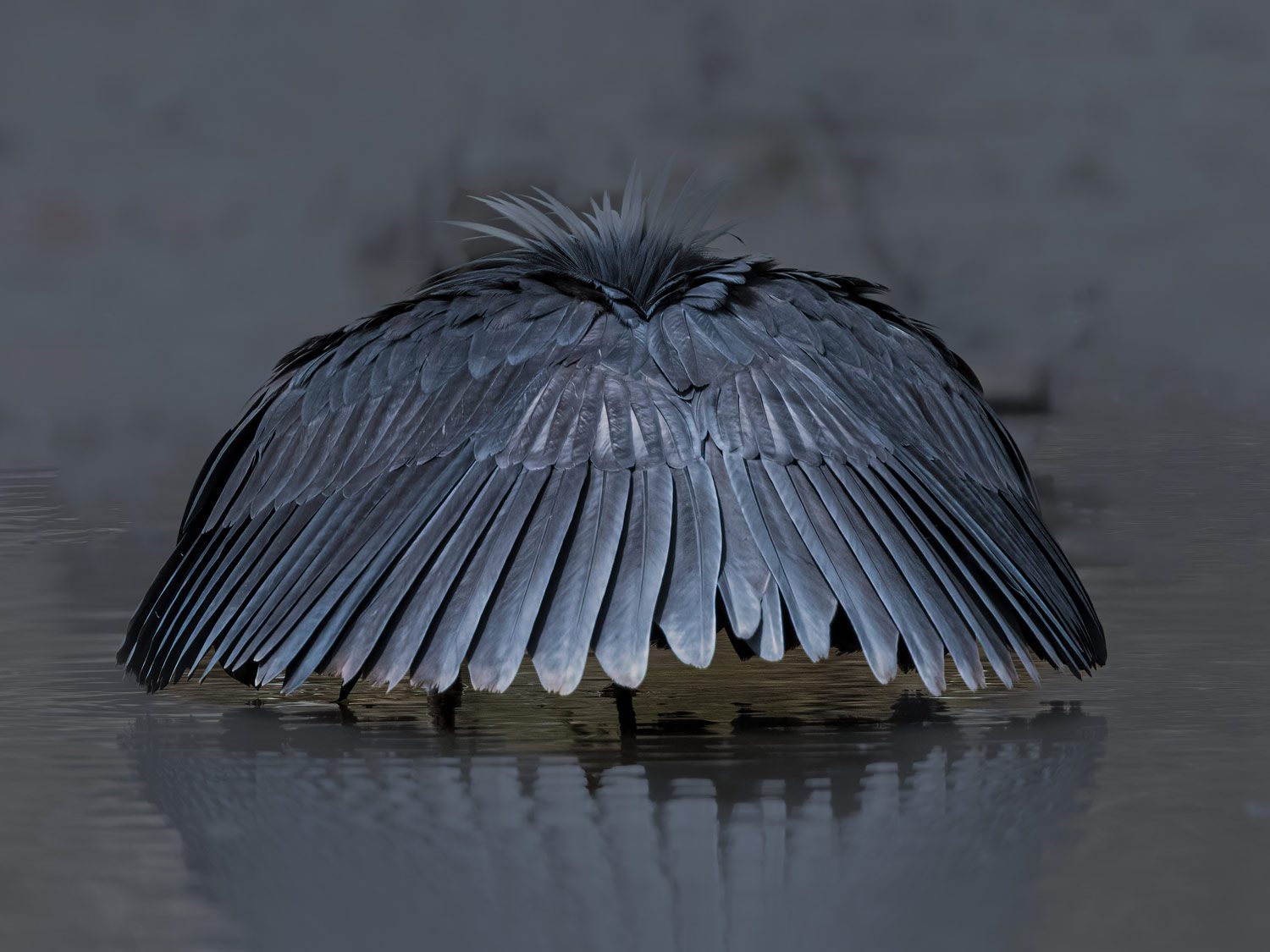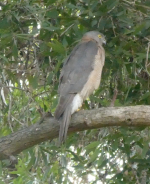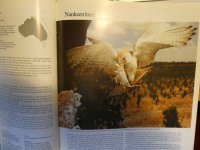-
Welcome to BirdForum, the internet's largest birding community with thousands of members from all over the world. The forums are dedicated to wild birds, birding, binoculars and equipment and all that goes with it.
Please register for an account to take part in the discussions in the forum, post your pictures in the gallery and more.
You are using an out of date browser. It may not display this or other websites correctly.
You should upgrade or use an alternative browser.
You should upgrade or use an alternative browser.
Perth Australia . Kestrel ? (1 Viewer)
- Thread starter richard866945
- Start date
More options
Who Replied?Deb Burhinus
Used to be well known! 😎

Maybe Collared Sparrowhawk certainly not a falcon though 😉
Larry Sweetland
Formerly 'Larry Wheatland'
My tentative guess would be Brown Goshawk (it's certainly either that or Collared Sparrowhawk)
Deb Burhinus
Used to be well known! 😎

I’m sure you are right Larry - I literally skipped over the image and just posted to say it wasn’t a falcon species - I am not familiar with either either species! (Although I assume similar differences apply as in comparing E. Sparrowhawk v N.Goshawk or Cooper’s v Sharp-shinned for example - tail tip shape, leg thickness/feathering/size;etc?)My tentative guess would be Brown Goshawk (it's certainly either that or Collared Sparrowhawk)
Last edited by a moderator:
Larry Sweetland
Formerly 'Larry Wheatland'
Yes, differences like that, but even less pronounced.I’m sure you are right Larry - I literally skipped over the image and just posted to say it wasn’t a falcon species - I am not familiar with either either species! (Although I assume similar differences apply as in comparing E. Sparrowhawk v N.Goshawk or Cooper’s v Sharptailed for example - tail tip shape, leg thickness/feathering/size;etc?)
Deb Burhinus
Used to be well known! 😎

Well I’ve looked at some online images and I can’t see present on this one image what are supposed to be the identifying features to separate these two species - it doesn’t look like it has a very furrowed heavy browed look in this image (which would point to BG) and it doesn’t look like it is longed legged either from this image. I can’t see the tip of the tail. I am not saying it’s not a BG but perhaps ‘THE FERN’ can explain what features he sees in the image that makes him, or anyone for that matter, so sure that this is a Brown Goshawk?
Interested to learn more!
Interested to learn more!
MJB
Well-known member
Toe shape, relative toe length and leg thickness together are valuable indicators, but not from this shot.Well I’ve looked at some online images and I can’t see present on this one image what are supposed to be the identifying features to separate these two species - it doesn’t look like it has a very furrowed heavy browed look in this image (which would point to BG) and it doesn’t look like it is longed legged either from this image. I can’t see the tip of the tail. I am not saying it’s not a BG but perhaps ‘THE FERN’ can explain what features he sees in the image that makes him, or anyone for that matter, so sure that this is a Brown Goshawk?
Interested to learn more!
MJB
Deb Burhinus
Used to be well known! 😎

Thanks MJB - agree this can’t be seen on this image and those features plus the ones I mentioned were on the ‘table’ I managed to find but I could find little else.Toe shape, relative toe length and leg thickness together are valuable indicators, but not from this shot.
MJB
Clearly something can be seen in this one image as THE FERN presumably ‘ticked’ Brown Goshawk because he thinks it is one - Having no experience here, I just wanted to know what those features are that can be seen!
Larry Sweetland
Formerly 'Larry Wheatland'
I can't see any mention of anyone saying they're sure it's a Brown Goshawk, or am I missing something? I said mine was a tentative guess, and I mostly mentioned Brown Goshawk because you hadn't mentioned it (the alternative) in your post. I just looked at it's face, thought it looked heavy-browed, and thought I should mention Brown Goshawk because in my experience it also tended to me the most common of the two in most places.Well I’ve looked at some online images and I can’t see present on this one image what are supposed to be the identifying features to separate these two species - it doesn’t look like it has a very furrowed heavy browed look in this image (which would point to BG) and it doesn’t look like it is longed legged either from this image. I can’t see the tip of the tail. I am not saying it’s not a BG but perhaps ‘THE FERN’ can explain what features he sees in the image that makes him, or anyone for that matter, so sure that this is a Brown Goshawk?
Interested to learn more!
Deb Burhinus
Used to be well known! 😎

Perhaps I misunderstood FERN’s thumbs up - I assumed he was confirming your suggestion of BG over my (very tentative!) suggestion of CS - these thumbs up buttons seem to get pressed for so many different reasons, they’re downright confusing at times and ambiguous apparently but ‘normally‘ to my mind they are a vote for the ID given by the recipient of the thumbs up but maybe I’m missing something?I can't see any mention of anyone saying they're sure it's a Brown Goshawk, or am I missing something?
(I didn’t interpret your ‘tentative’ guess as anything but ‘tentative’ and took your post at face value, sorry if that wasn’t clear - I just wondered why FERN (or anyone else) agreed with that guess that’s all. I guess I’ll have to wait for his reasons I don’t expect anyone else to answer that.
So are there no other features - apart from the ‘browed look’ (which I’m struggling to see but please don’t take that as meaning I think it’s in your imagination 😉) that can pin this down?
PS. I have absolutely no experience of either of these as I said, so this is purely an interest in learning more.
Maroon Jay
Airborne

Agree with Larry. Looks like Brown Goshawk. Collared Sparrowhawk is the same but much smaller. If it is a big bird 40-55 cm it is Brown Goshawk. If it is small 30-40 cm (the size of Australian Cuckoo-shirke, then it is the Sparrowhawk.
MikeMules
Well-known member
It looks more like a Collared Sparrowhawk to my mind (but by no means certain)- there doesn't appear to be a pronounced brow-ridge and there is the hint of the blue on the beak extending past the cere (but that could well be an artefact of the photo/light). The overall proportions of the head to body look a bit more Sparrowhawk to me, but without some way to judge scale it can't be more than a guess on that aspect, or on the overall size of the bird. The legs aren't visible and the tail looks to be growing back in, so isn't useful for i.d. in this case.
Deb Burhinus
Used to be well known! 😎

So there’s overlap in size then (albeit just a cm assuming this is the fem. of the CS being as large as the male BG)Agree with Larry. Looks like Brown Goshawk. Collared Sparrowhawk is the same but much smaller. If it is a big bird 40-55 cm it is Brown Goshawk. If it is small 30-40 cm (the size of Australian Cuckoo-shirke, then it is the Sparrowhawk.
So in this image, what are you using in the image as a relative size measurement that tells us how large the OP is if you dont mind me asking? A perched bird in the trees is very hard to assess wing length and body length (the wingspan I assume you are referring to here in cm?)
Reading out sizes from guidebooks isn’t helping me here! 🙂
Larry Sweetland
Formerly 'Larry Wheatland'
I think most people consider them a hard pair to identify a lot of the time. I'm sure I can remember quite a few BF threads over the years that have been unresolved. Tail shape can be useful (but with care like with Cooper's vs Sharp-shinned.) And, as has been mentioned the legs/toes which you can't see in this shot.
If an experienced Aussie confidently goes with one or the other, I'd go with that!
If an experienced Aussie confidently goes with one or the other, I'd go with that!
Deb Burhinus
Used to be well known! 😎

I have to be honest, confessing again my complete ignorance here of either of these species but my gut reaction when I opened the OP image was in response to ‘is it a kestrel?’ was ‘it’s not a falcon at all but a Sparrowhawk species’. It did not immediately strike me as a Goshawk species. Just split second gut reactions based on some basic and general familiarity with other accipters in the genus. Nothing more nothing less and certainly not based on anything grounded in experience of the pair of sp in question. However, it was enough of a reaction to want to know why BG was/is a preferred ID.
sicklebill
well-known Cretaceous relic

A tough call on this photo, and all the features that separate have been mentioned, but overall my impression FWIW is Brown Goshawk, it looks big and mean
Maroon Jay
Airborne

It is impossible to tell the size from the photo but it seems to be perched on a fairly thick branch which implies a large bird (or maybe it just seems that way to me.) I was hoping the person who saw the bird, would read that and tell us if he saw a large bird or a small one. Yes, the size I gave was in cm.So in this image, what are you using in the image as a relative size measurement that tells us how large the OP is if you dont mind me asking? A perched bird in the trees is very hard to assess wing length and body length (the wingspan I assume you are referring to here in cm?)
Deb Burhinus
Used to be well known! 😎

Impressions and guesstimates of size are subjective impressions and with all due respect, comparing the size of one species with another when it is sitting above eye level on a branch (that you have no idea of thickness of the branch or the distance from the camera) is pure guesswork imo.it is impossible to tell the size from the photo
Look at this CS looming large above eye level

Planned Outage for Some Cornell Lab Services
Several Cornell Lab of Ornithology services will be unavailable beginning March 19 through 6:00 a.m. U.S. Eastern time on March 21. This is a one-time disruption while we migrate more than 1.6 billion eBird observations and additional project data to new servers. After the move, our websites will ha

Planned Outage for Some Cornell Lab Services
Several Cornell Lab of Ornithology services will be unavailable beginning March 19 through 6:00 a.m. U.S. Eastern time on March 21. This is a one-time disruption while we migrate more than 1.6 billion eBird observations and additional project data to new servers. After the move, our websites will ha
It might help to know the sex too? Clearly an adult so are both species sexually dimorphic in appearance as well as size?
Most raptors look ‘mean’ when viewed from below because of their eyebrow bone - Look at the hooded brow of this Collared Sparrowhawk from below eye level, (the wide eyed look accentuated by a yellow orbital ring rather than the glare of BG). Note the cere colour (creamy)

Planned Outage for Some Cornell Lab Services
Several Cornell Lab of Ornithology services will be unavailable beginning March 19 through 6:00 a.m. U.S. Eastern time on March 21. This is a one-time disruption while we migrate more than 1.6 billion eBird observations and additional project data to new servers. After the move, our websites will ha
It’s all just devil’s advocate though,🙂
These are the criteria I have been referring too
I don’t think Collared Sparrowhawk has been ruled out by anyone here - Mike has provided some tangible observations supporting CS and Sicklebill some valid subjective observations based on experience why it is better for Brown Goshawk. Larry has given good reason why it’s more probable on distribution but as far as ascertaining and then applying any ID criteria here, I feel absolutely none the wiser - I do agree it looks bulky though (but not, in a powerful way, in a fluffed up feathers way!) 😏
richard866945
Bino repair man
Deb Burhinus
Used to be well known! 😎

Hi Richard
I can absolutely assure you this is no Kestrel. Kestrels are Falcons. and the one thing falcon species have in common is long wings - when perched, their wings come two thirds to completely down to the tips of their tails. Your bird is an accipiter, like our Sparrowhawk or Goshawk in the UK.
Look at the length of the wings on this Kestrel

 macaulaylibrary.org
and compare it to yours.
macaulaylibrary.org
and compare it to yours.
You brother is incorrect on this occassion. It’s a little annoying to be honest, when people like myself, have given our valuable time and experience to helping you out and you respond by completely ignoring the reliable answers you have been given and choose instead to opt for something even a birder with the most basic of skills could see is wrong.
PS I haven’t heard the term ‘Windhover’ being used for many years to describe a Common Kestrel!
I can absolutely assure you this is no Kestrel. Kestrels are Falcons. and the one thing falcon species have in common is long wings - when perched, their wings come two thirds to completely down to the tips of their tails. Your bird is an accipiter, like our Sparrowhawk or Goshawk in the UK.
Look at the length of the wings on this Kestrel

Planned Outage for Some Cornell Lab Services
Several Cornell Lab of Ornithology services will be unavailable beginning March 19 through 6:00 a.m. U.S. Eastern time on March 21. This is a one-time disruption while we migrate more than 1.6 billion eBird observations and additional project data to new servers. After the move, our websites will ha
You brother is incorrect on this occassion. It’s a little annoying to be honest, when people like myself, have given our valuable time and experience to helping you out and you respond by completely ignoring the reliable answers you have been given and choose instead to opt for something even a birder with the most basic of skills could see is wrong.
PS I haven’t heard the term ‘Windhover’ being used for many years to describe a Common Kestrel!
Last edited:
Users who are viewing this thread
Total: 2 (members: 0, guests: 2)





